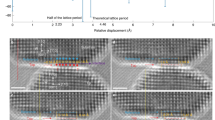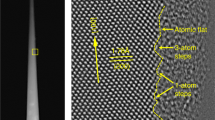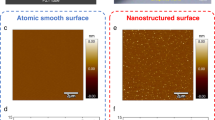Abstract
Understanding friction1,2,3,4 and wear5,6,7,8,9,10,11 at the nanoscale is important for many applications that involve nanoscale components sliding on a surface, such as nanolithography, nanometrology and nanomanufacturing. Defects, cracks and other phenomena that influence material strength and wear at macroscopic scales are less important at the nanoscale, which is why nanowires can, for example, show higher strengths than bulk samples12. The contact area between the materials must also be described differently at the nanoscale13. Diamond-like carbon is routinely used as a surface coating in applications that require low friction and wear because it is resistant to wear at the macroscale14,15,16,17,18,19,20, but there has been considerable debate about the wear mechanisms of diamond-like carbon at the nanoscale because it is difficult to fabricate diamond-like carbon structures with nanoscale fidelity. Here, we demonstrate the batch fabrication of ultrasharp diamond-like carbon tips that contain significant amounts of silicon on silicon microcantilevers for use in atomic force microscopy. This material is known to possess low friction in humid conditions, and we find that, at the nanoscale, it is three orders of magnitude more wear-resistant than silicon under ambient conditions. A wear rate of one atom per micrometre of sliding on SiO2 is demonstrated. We find that the classical wear law of Archard21 does not hold at the nanoscale; instead, atom-by-atom attrition7,8 dominates the wear mechanisms at these length scales. We estimate that the effective energy barrier for the removal of a single atom is ∼1 eV, with an effective activation volume of ∼1 × 10−28 m3.
This is a preview of subscription content, access via your institution
Access options
Subscribe to this journal
Receive 12 print issues and online access
$259.00 per year
only $21.58 per issue
Buy this article
- Purchase on Springer Link
- Instant access to full article PDF
Prices may be subject to local taxes which are calculated during checkout



Similar content being viewed by others
References
Persson, B. N. J. Sliding Friction (Springer, 2000).
Gnecco, E. Fundamentals of Friction and Wear on the Nanoscale (Springer, 2006).
Mo, Y., Turner, K. T. & Szlufarska, I. Friction laws at the nanoscale. Nature 457, 1116–1119 (2009).
Gnecco, E. et al. Velocity dependence of atomic friction. Phys. Rev. Lett. 84, 1172–1175 (2000).
Bhushan, B., Israelachvili, J. N. & Landman, U. Nanotribology: friction, wear and lubrication at the atomic scale. Nature 374, 607–616 (1995).
Carpick, R. W. & Salmeron, M. Scratching the surface: fundamental investigations of tribology with atomic force microscopy. Chem. Rev. 97, 1163–1194 (1997).
Gotsmann, B. & Lantz, M. A. Atomistic wear in a single asperity sliding contact. Phys. Rev. Lett. 101, 125501 (2008).
Bennewitz, R. & Dickinson, J. T. Fundamental studies of nanometer-scale wear mechanisms. MRS Bull. 33, 1174–1180 (2008).
Maw, W., Stevens, F., Langford, S. C. & Dickinson, J. T. Single asperity tribochemical wear of silicon nitride studied by atomic force microscopy. J. Appl. Phys. 92, 5103–5109 (2002).
Bhushan, B. & Kwak, K. J. Velocity dependence of nanoscale wear in atomic force microscopy. Appl. Phys. Lett. 91, 163113 (2007).
Gnecco, E., Bennewitz, R. & Meyer, E. Abrasive wear on the atomic scale. Phys. Rev. Lett. 88, 215501 (2002).
Zhu, T., Li, J., Ogata, S. & Yip, S. Mechanics of ultra-strength materials. MRS Bull. 34, 167–172 (2009).
Luan, B. & Robbins, M. O. The breakdown of continuum models for mechanical contacts. Nature 435, 929–932 (2005).
Grill, A. Review of the tribology of diamond-like carbon. Wear 168, 143–153 (1993).
Erdemir, A. & Donnet, C. Tribology of diamond-like carbon films: recent progress and future prospects. J. Phys. D 39, R311–R327 (2006).
Neuville, S. & Matthews, A. A perspective on the optimisation of hard carbon and related coatings for engineering applications. Thin Solid Films 515, 6619–6653 (2007).
Robertson, J. Diamond-like amorphous carbon. Mater. Sci. Eng. R 37, 129–281 (2002).
Bowden, F. P. & Hanwell, A. E. Friction and wear of diamond in high vacuum. Nature 201, 1279–1281 (1964).
Donnet, C. & Erdemir, A. Tribology of Diamond-Like Carbon Films (Springer, 2007).
Bhushan, B. Modern Tribology Handbook (CRC Press, 2001).
Archard, J. F. Contact and rubbing of flat surfaces. J. Appl. Phys. 24, 981–988 (1953).
Niedermann, P. et al. CVD diamond probes for nanotechnology. Appl. Phys. A 66, S31–S34 (1998).
Oesterschulze, E. et al. Fabrication of small diamond tips for scanning probe microscopy application. Appl. Phys. Lett. 70, 435–437 (1997).
Kim, K. et al. Novel ultrananocrystalline diamond probes for high-resolution low-wear nanolithographic techniques. Small 1, 866–874 (2005).
Grierson, D. S. Nanotribological properties of nanostructured hard carbon thin films. PhD thesis, Univ. Wisconsin (2008).
Chung, K. & Kim, D. Fundamental investigation of micro wear rate using an atomic force microscope. Tribol. Lett. 15, 135–144 (2003).
Bares, J., Sumant, A., Grierson, D., Carpick, R. & Sridharan, K. Small amplitude reciprocating wear performance of diamond-like carbon films: dependence of film composition and counterface material. Tribol. Lett. 27, 79–88 (2007).
Choi, J., Kawaguchi, M., Kato, T. & Ikeyama, M. Deposition of Si-DLC film and its microstructural, tribological and corrosion properties. Microsyst. Technol. 13, 1353–1358 (2007).
Bhushan, B. Introduction to Tribology (Wiley, 2002).
Anders, A. Handbook of Plasma Immersion Ion Implantation and Deposition (Wiley-Interscience, 2000).
Reeber, R. R. R. O. & Sridharan, K. O. W. Plasma source ion implantation. Adv. Mater. Proc. 146, 21–23 (1994).
Glocker, D. A. & Shah, S. I. Handbook of Thin Film Process Technology (Institute of Physics Publishing, 1995).
Sader, J. E., Chon, J. W. M. & Mulvaney, P. Calibration of rectangular atomic force microscope cantilevers. Rev. Sci. Instrum. 70, 3967–3969 (1999).
Tambe, N. S. & Bhushan, B. Friction model for the velocity dependence of nanoscale friction. Nanotechnology 16, 2309–2324 (2005).
Acknowledgements
H.B. and A.S. acknowledge the experimental support of W. Haeberle, M. Pede and P. Baechtold. The authors thank C. Bolliger for proofreading the manuscript. H.B. acknowledges partial support from the European Commission through grant no. FP6-2005-IST-5-34719 for the project ProTeM. R.W.C. acknowledges partial support provided for this research by the Nano/Bio Interface Center through the National Science Foundation NSEC DMR-0425780.
Author information
Authors and Affiliations
Contributions
H.B. wrote this manuscript with inputs from all authors. H.B. and B.G. analysed the data, with participation of M.A.L. H.B., U.D. and M.D. participated in the fabrication of the cantilevers. Y.C. and K.S. optimized the plasma process parameters for deposition and performed the deposition. P.J. performed the TEM imaging of the tips and with R.W.C. interpreted the results of TEM. H.B., B.G., A.S., R.W.C. and M.A.L. designed the wear experiment. H.B. and A.S. performed the experiments and collected the data. H.B., B.G., M.A.L. and R.W.C. analysed and interpreted the results.
Corresponding authors
Ethics declarations
Competing interests
The authors declare no competing financial interests.
Supplementary information
Supplementary information
Supplementary information (PDF 1177 kb)
Supplementary information
Supplementary movie 1 (AVI 36347 kb)
Supplementary information
Supplementary movie 2 (AVI 36855 kb)
Rights and permissions
About this article
Cite this article
Bhaskaran, H., Gotsmann, B., Sebastian, A. et al. Ultralow nanoscale wear through atom-by-atom attrition in silicon-containing diamond-like carbon. Nature Nanotech 5, 181–185 (2010). https://doi.org/10.1038/nnano.2010.3
Received:
Accepted:
Published:
Issue Date:
DOI: https://doi.org/10.1038/nnano.2010.3
This article is cited by
-
Transition from Plastic Shearing to Fracture of Asperity Junctions: Role of a Critical Aspect Ratio
Tribology Letters (2023)
-
Control of Nanoscale Ripple Formation on Ionic Crystals by Atomic Force Microscopy
Tribology Letters (2023)
-
Capillary grip-induced stick-slip motion
Nano Research (2022)
-
Review of recent progress on in situ TEM shear deformation: a retrospective and perspective view
Journal of Materials Science (2022)
-
Molecular Dynamics Examination of Sliding History-Dependent Adhesion in Si–Si Nanocontacts: Connecting Friction, Wear, Bond Formation, and Interfacial Adhesion
Tribology Letters (2021)



